MAKING IT STICK. Trainer Bob Stewart holds a shoe while Steve Stanley applies Equilox to it in preparation for gluing it on the trotter’s hoof.
I've been shoeing horses for more than 20 years at The Red Mile in Lexington, Ky., as well as at other tracks. When I started, the standard shoes for a trotter at that time were 5/8-inch half rounds, often with a big leather pad. A trotter with 4-inch toes wasn’t uncommon.
Heavy shoes, heavy pads and long toes are quite uncommon today in Standardbreds. As the breed evolves, those of us who shoe them must follow this evolution by altering our methods.
Most of the trotters that I shoe today start with a 9/16-inch half-round shoe in front, and some start with a 1/2-inch half-round. A 5/8-inch half-round is rarely used. Toe weights and similar modifications are basically a thing of the past. I haven’t put a set of toe weights on in 3 years.
If a horse can stay on gait with lighter shoes and a lighter set-up, he’s going to go faster. It’s as simple as that.
Fortunately, we have many new options to offer trainers, as there are shoes being used now that weren’t even available 5 years ago. At the 2003 American Farrier’s Association convention, I picked up a catalog from an Italian company that showed a whole new line of aluminum shoes, many of them geared toward Standardbreds. It’s a whole new world.
It’s my job to know what shoeing options are available to correct various problems. The way it usually works is that a trainer will describe a horse’s problem to me and I’ll tell him my thoughts on how to overcome the problem. Together we form a strategy based on the trainer’s insight into his horse and my insight into shoeing.
I’ve also had trainers come to me with shoes that I’ve never seen. Arild Eggen brought me a set of shoes to use on his trotter, Norvelous Hanover, last year. These were light, flat shoes that had carbide tips welded around the outer rim. Norvelous Hanover did very well in those shoes. Eggen had picked them up in his native country, Norway.
I’ve been fortunate to shoe for some of the respected Hall of Famers in harness racing, such as Howard Beissinger and John Patterson. They were very particular about how they wanted their horses shod and they had a vast knowledge of shoeing.
I remember when Howard Beissinger had Defiant One in 1987. That colt was plagued with chronic quarter cracks, but Beissinger and his assistant John Roach stayed on top of them. Defiant One won the Breeders Crown despite having two quarter cracks.
Shoeing of horses is much different in the 21st century, but one thing remains the same: A good horse doesn’t need a lot of fancy shoeing. If you shoe the horse fundamentally sound and plain, a good horse is still going to be a good horse.
There are many products that follow the principle of fundamental shoeing. Here are a few.
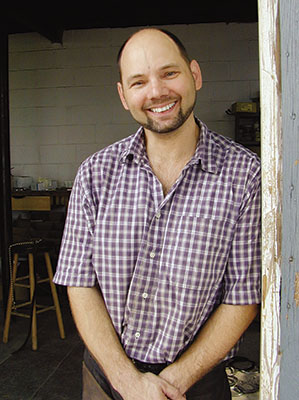
TOP SHOER. Steve Stanley has shod many of the best Standardbred racers in the sport over the past two decades from his shoeing shop at The Red Mile in Lexington, Ky.
“Flip-Flops” or Combi Pads
I think that these originally came from Denmark (from PP Plastics), but when they became popular with American trainers, we found them to be very useful.
Flip-flops don’t alter a horse’s gait much, but they do put a lot of weight in the heel and cushion the foot very well. But the biggest benefit is with the horses that aren’t 100-percent sound. Trainer Bob Stewart told me that we have helped horses with sore knees when we have put on flip-flop pads. They also give some benefit to horses with sore feet.
You put a half-shoe on the front of the flip-flop pads. I would say that the shoe I most commonly use is a 1/2-inch half-round, but you can use any type of shoe with it: full swedge, aluminum or whatever the horse needs for traction and gait. But because you’re adding weight with the flip-flop pad itself, try to go lighter — like a 1/2-inch half-round or, in some cases, aluminum — with the shoe.
You can overdo them, however. I feel you can’t leave the flip-flops on all the time, because the frog will recess after a while. And in some cases, the frog can be at a lower level than the heels—a dangerous situation. The frog stays very soft under the flip-flop.
Cutting the middle out of the toe area of the flip-flop pad seems to help somewhat. When the foot stays very soft, it is more susceptible to spreading out, and is more easily bruised.
This is much like a horse wearing a full pad. After pulling the pad, the foot is as soft as butter. That’s because the moisture is trapped beneath the pad. Sometimes it is better to leave the flip-flops off the foot for one or two shoeings to let the foot recover.
The flip-flop shoes are made out of some type of rubber compound, and they wear incredibly well, often allowing for resets.
KB Egg Bars
A KB egg bar shoe is ideal for horses with bad feet, and it is particularly good for a horse with sore soles. This shoe is a little thicker, and thus it gives you more concavity and traction.
The egg bar is also very helpful for weak-heeled horses, giving support to the heels and to the entire limb. Because they are aluminum, they add more metal, which gives support without going overboard on weight.
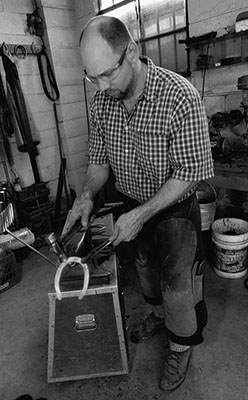
AT THE ANVIL. Steve Stanley at work at his anvil. The farrier, who was born in Bellefonte, Pa., and now lives in Versaillies, Ky., says as breeds have evolved, the way farriers must shoe them has evolved as well.
Circuit Bars
Circuit Bars (from Grand Circuit) are 1/8-inch-thick aluminum plates with a continuous bar across the heel or as a Sabilizer with a web pattern across the entire sole. They are used like pads and can be applied to any shoe.
We’ve had some remarkable success with these. Bob Stewart told me that Cameron Hall would not have raced in last year’s Breeders Crown without them. That alone says a mouthful about their value in shoeing a horse.
Cameron Hall had a problem with an abscess in one heel and the Circuit plates proved to be very therapeutic. They are very lightweight and give the hoof a lot of support in the heels. Being wider than the shoe, they protect the sole more than just a shoe alone.
Many trainers and drivers feel horses can’t be as good in bar shoes. With normal bar shoes, they are often correct. Circuit plates are recessed from the ground surface of the shoe, thereby reducing the drag of a normal bar. They have a size number stamped in the center of the bar. Often, after the horse has worn Circuit plates for a while, the number is still readable. That proves to me that part of the plate is not dragging the track — the No. 1 reason that regular bar shoes change a horse’s gait.
The weight of the Circuit plate is insignificant compared to normal bars. That’s the other reason that bar shoes affect the gait. I’ve been using more and more Circuit plates.
Star Shoes
A star shoe or PG shoe is an aluminum plate you can screw a rubber shoe on to. The plate gets nailed to the hoof with special headless nails, and you have some options on the shoe as far as how much grab you want to use.
Arild Eggen says that they are good for sore horses, but I really don’t have that much experience with them. The base plate works just like a full pad, but seems to be strong enough to protect the foot in spite of the sole getting too soft. I have noticed no bruising whatsoever underneath star shoes.
Open-Toe Shoes
This is not as new as some of the other options. We’ve been shoeing horses with open toes for years, but it is worth mentioning. When I speak about an open-toe shoe, I mean basically turning the shoe around backward so that the opening of the shoe is at the front toe instead of in the heel. That alters a horse’s gait significantly.
Years ago horsemen used quarter boots with lead weights or hinged quarter boots to encourage a horse to fold. That weight in the heel accomplished that, and it’s much the same today with open-toe shoes. The weight is in the heel, and the open toes facilitate breaking over in front. That’s an ideal combination for a young trotter who isn’t set in its gait.
I would say that more horses train in open-toe shoes than race in them, but they can race in them. A horse with an open-toe shoe, however, tends to slip a lot, because there is nothing in the toe to grab. You can put some Borium along the ends of the shoe to help the horse get some traction, but you still have that opening in front.
Any type of shoe can be put on backward — half-rounds or flat shoes are the most common, but I have even seen swedge shoes put on backward.
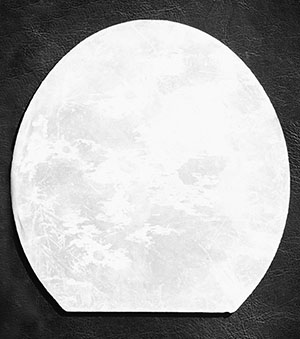
Circuit Bar
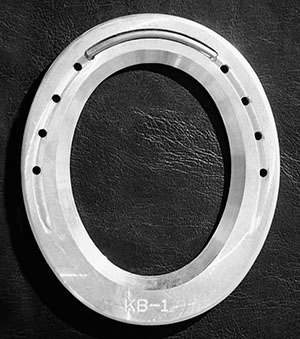
KB Egg Bar
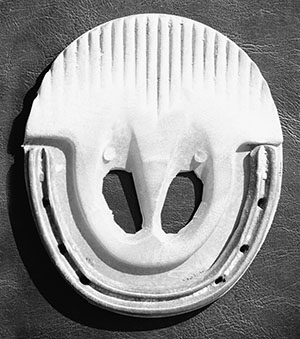
Flip-Flop or Combi-Pad
Equilox
This is an amazing product. (There is a similar product put out by Grand Circuit Products.) They’re both two-part epoxies with a base and a hardener. You mix the two together, and then you have a very limited time, depending on the weather, to apply it to the foot and to work with it. In dry, warm weather, the compound sets up very rapidly.
Equilox starts out at about the consistency of pudding, and you can mold it like clay to the shape that you want to rebuild a foot. You can also add fiberglass sheets to build up a hoof wall.
With a sore-footed horse, Equilox can give you immediate results. A horse can be sore one moment and fine after you build a new foot with Equilox. You can also eliminate the stress of using nails in the hoof walls by rebuilding the hoof wall, or by using glue-on shoes.
You can also use Equilox to patch quarter cracks. You still have to do all the normal work under the crack, but you can certainly use it as your patch material. Once the Equilox hardens, you can rasp it, drive nails through it, or do whatever you wish.
Equilox is also used on young foals to build up one side of a foot, for example. This is a significant step forward in helping correct limb problems. You can build an extension onto a hoof wall to help the foal correct itself.
Fortunately, breeding farms are using Equilox and other products to help foals overcome flaws. That’s probably coming from veterinarians who are doing more surgeries to help foals and that’s raising the awareness of the breeding farms.
Early intervention with corrective trimming is important. If you wait until the foal is a yearling, it’s too late. These measures are most important when the foal is in rapid growth stages.
One warning to people who work with Equilox, however, is that you need to be very careful around exposed tissue.
If a horse has an injury and Equilox comes in contact with exposed tissue, it can burn and kill that tissue. That’s because Equilox generates so much heat in the curing process.
You can also use Equilox to glue on shoes with no nails at all. This can be very helpful for a lot of obvious reasons. If you use Equilox to glue on shoes over a period of time, however, you will notice the heels will begin to contract, as they do not move at all with a glue-on shoe. The glue-on shoe locks the heels in place, and stops the normal expansion of the hoof when loaded by the weight of the horse.
Glue-ons are another strategy that can give instant and dramatic results in some horses. They stay on very well. I have had only two instances of them coming off.
Barefoot Racing
The ultimate in shoeing a horse light, of course, is simply to pull the shoes entirely and race the horse barefoot.
I have a board with shoes from some of the best horses that I’ve shod, and I’ve nailed shoes from Express Ride 4, who ran 1:53 on the board. That’s actually misleading, because Express Ride often raced barefoot when he was older, and he was barefoot when he trotted to his record at The Red Mile.
I probably see more horses racing barefoot than most other farriers, because the surface at The Red Mile is so forgiving that trainers can race their horses barefoot on it. Horses get a very good natural traction when racing over The Red Mile.
I remember that when the Team Nordin Stable was racing one fall at Lexington, many of the horses would race barefoot on the weekend and then get shoes nailed back on before they went out on Monday morning. If a trainer didn’t put shoes back on for the jogging and training miles, he’d really be at risk with his horses, because the foot would simply erode too fast.
It’s more common to see the shoes pulled on a trotter than on a pacer, and it’s often only the front shoes that are pulled. But sometimes you see all four shoes pulled, too.
Horses will trot a little cleaner when they go barefoot, because it’s the shoe that is actually hitting the hind shin. If you eliminate the shoe, you give the horse more room to clear.
Of course, there is a note of caution there, too, because if you’re constantly pulling shoes and nailing them back on, you’re compromising the hoof wall. You have to be careful about where you place your nails.
New Products
When attending the annual conventions of the American Farrier’s Association, it seems that everyone has a new shoe out. These are great places to learn and get new ideas. If I just stay in my shop, I won’t be exposed to many new ideas.
Also, I have seen a lot of different techniques from Scandinavian shoers. Many of the Scandinavian trainers are very capable of shoeing their own horses. They are a good source of insight into the effects of shoes on a horse’s gait, because they not only put the shoes on but they also sit behind the horse in its miles.
Shoeing Standardbreds has changed a lot since I started two decades ago, and I’m quite sure it will change a lot more in the coming years. But while products change, the importance of hoof balance remains a key to the horse’s productivity.
Balance Still The Key
There is no question that the floor work done by the farrier is the most important part of shoeing. Different types of shoes may come and go, but the fundamental mechanics of foot balance are still critical for soundness and performance.
The foot surrounds the coffin bone, and the coffin bone is the skeletal base of the entire horse. The stress of any deviation from good balance in a racehorse is multiplied many times over with each stride taken at race speed.
I believe that no horse can compete at his or her personal best on the track without the basic and proper hoof balance that is required with every shoeing of the horse. All shoeing applications are secondary to that basic principle.

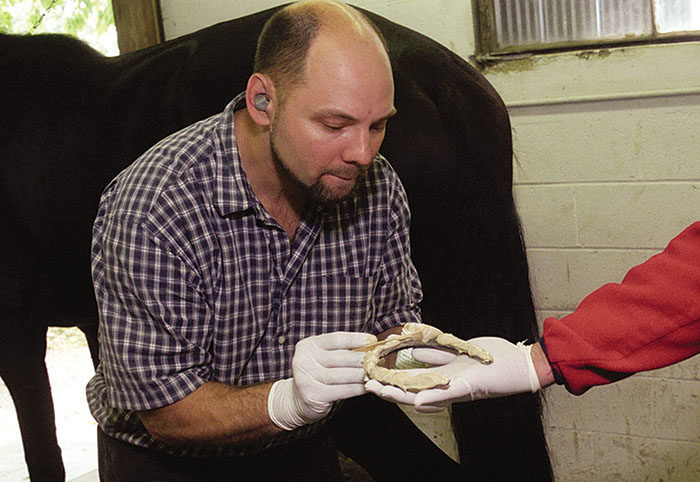







Post a comment
Report Abusive Comment